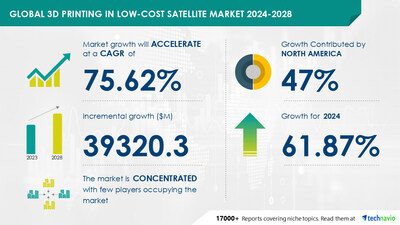3D Printing in Low-Cost Satellite Market to Grow by USD 39.32 Billion from 2024-2028, Driven by Rapid Satellite Development; Market Evolution Powered by AI – Technavio
NEW YORK, Sept. 30, 2024 /PRNewswire/ — Report on how AI is driving market transformation – The Global 3D Printing in Low-Cost Satellite Market size is estimated to grow by USD 39.32 billion from 2024-2028, according to Technavio. The market is estimated to grow at a CAGR of 75.62% during the forecast period. Rapid development and deployment of low-cost satellites is driving market growth, with a trend towards increasing number of space exploration missions However, scalability issues associated with 3D printing in low-cost satellite manufacturing poses a challenge – Key market players include Airbus SE, EOS GmbH, L3Harris Technologies Inc., Lockheed Martin Corp., Stratasys Ltd., and The Boeing Co..
Key insights into market evolution with AI-powered analysis. Explore trends, segmentation, and growth drivers- View the snapshot of this report
3D Printing In Low-Cost Satellite Market Scope | |
Report Coverage | Details |
Base year | 2023 |
Historic period | 2018 – 2022 |
Forecast period | 2024-2028 |
Growth momentum & CAGR | Accelerate at a CAGR of 75.62% |
Market growth 2024-2028 | USD 39320.3 million |
Market structure | Concentrated |
YoY growth 2022-2023 (%) | 61.87 |
Regional analysis | North America, Europe, APAC, South America, and Middle East and Africa |
Performing market contribution | North America at 47% |
Key countries | US, China, UK, Germany, and Japan |
Key companies profiled | Airbus SE, EOS GmbH, L3Harris Technologies Inc., Lockheed Martin Corp., Stratasys Ltd., and The Boeing Co. |
Market Driver
The space industry witnessed significant advancements in 2023, with multiple space exploration missions launched by renowned organizations such as the European Space Agency (ESA) and the Indian Space Research Organization (ISRO). Notably, ESA’s Jupiter Icy Moons Explorer (Juice) mission was set to reach Jupiter by July 2031, while ISRO’s Chandrayaan-3 mission was successfully launched at a cost under USD100 million. Additionally, SpaceX launched 91 satellites using the Falcon 9 rocket. These milestones were accompanied by groundbreaking developments, including the first-ever 3D-printed rocket launch by SpaceX in Florida and two Starship test launches in Texas. The increasing number of space missions will fuel the demand for cost-effective satellites, thereby propelling the growth of the global 3D printing in low-cost satellite market in the forecast period.
3D printing is revolutionizing the low-cost satellite market by enabling the production of housing, propulsion systems, and components for Nano and Microsatellites and Small Satellites. Advanced printer technology and materials from material suppliers are reducing satellite production costs for satellite manufacturers and space agencies. Budget-conscious space industry players are adopting 3D printing equipment for waste reduction and efficient production of satellite parts. This trend is particularly relevant for space exploration, satellite constellations, and small satellite missions. Components like antennas, brackets, and shields are being 3D printed for communication, Earth observation, navigation, internet access, telecommunications, broadcasting services, military operations, and more. Overall, 3D printing technology is transforming the space industry by making satellite manufacturing more accessible and cost-effective.
Request Sample of our comprehensive report now to stay ahead in the AI-driven market evolution!
Market Challenges
- The implementation of 3D printing in low-cost satellite manufacturing presents significant opportunities, but scalability remains a primary challenge. While 3D printing offers cost savings for creating small, complex components, its limitations in large-scale or high-volume production pose concerns. Three main scalability issues include printing speed, material compatibility, and post-processing challenges. 3D printers are slow in producing large and complex satellite parts, making it difficult to meet high-volume requirements within a short timeframe. Additionally, some materials required for low-cost satellite manufacturing are not compatible with 3D printers, reducing the available options. Lastly, post-processing steps, such as polishing, sanding, and painting, are labor-intensive and time-consuming, making it challenging to scale to high-volume production. These challenges may hinder the growth of the low-cost satellite manufacturing market during the forecast period.
- In the low-cost satellite market, housing, propulsion, and manufacturing challenges persist for Nano and Microsatellites and Small Satellites. Traditional satellite production methods face budget constraints, making 3D printing an attractive alternative. 3D printer technology, materials, and printing techniques offer solutions for satellite manufacturers and space agencies. Material suppliers are crucial for advanced printing technology, ensuring the production of high-quality satellite components. The space industry benefits from waste reduction through 3D printing, enabling space exploration and satellite constellations. Small satellite missions rely on 3D printing for producing essential components like antennas, brackets, and shields. Communication, Earth observation, navigation, internet access, telecommunications, broadcasting services, military operations, and more can be enhanced through satellite-based services made possible by this innovative technology. 3D printing equipment and materials are essential for producing satellite components, reducing costs and increasing efficiency. The use of 3D printing technology in satellite manufacturing is revolutionizing the space industry, enabling the production of complex structures and custom parts for various space applications.
Discover how AI is revolutionizing market trends- Get your access now!
Segment Overview
This 3d printing in low-cost satellite market report extensively covers market segmentation by
- Application
- 1.1 Aerospace and defense
- 1.2 Scientific research
- Product
- 2.1 Power system
- 2.2 Framework
- 2.3 Antenna
- Geography
- 3.1 North America
- 3.2 Europe
- 3.3 APAC
- 3.4 South America
- 3.5 Middle East and Africa
1.1 Aerospace and defense- The demand for low-cost satellites is escalating in the aerospace and defense sectors due to the growing requirement for affordable and dependable satellite technology for various mission-critical applications. Small satellites, also known as low-cost satellites, offer several advantages over conventional, larger satellites. They have lower manufacturing and launch costs and faster deployment times. The global defense sector is witnessing a consistent increase in spending on defense, creating a significant market opportunity for low-cost satellites. For instance, the US Department of Defense (DoD) is investing in advanced technology and communication, surveillance, and reconnaissance capabilities by developing small satellites equipped with multiple sensors. The US government’s proposed budget for the fiscal year 2022 includes USD1.9 billion in funding for space programs, including low-cost satellite initiatives. One of the significant benefits of 3D printing in low-cost satellite and aerospace applications is the ability to produce parts with complex geometries, which cannot be manufactured using traditional methods. 3D printing also enables on-demand manufacturing, reducing lead times and streamlining supply chain processes. This capability is crucial in the aerospace and defense sector, where timely delivery is essential. For example, SpaceX, the space venture company owned by Elon Musk, has successfully launched Falcon 9 rockets with 3D-printed parts, significantly reducing the cost of its spaceflights. The use of 3D-printed low-cost satellites provides several benefits, including reducing manufacturing costs and timelines and enabling companies to send satellites into orbit more frequently. For instance, NASA launched the world’s first 3D-printed satellite in 2015, and Alba Orbital developed the PocketQube satellite in February 2022. The defense sector is also exploring the use of 3D-printed low-cost satellites. For example, the US Air Force (USAF) is collaborating with Aerojet Rocketdyne and 3D printing company Stratasys to develop 3D-printed rockets for space missions, aiming to reduce manufacturing time and cost to support military operations. In conclusion, the increasing application of 3D-printed low-cost satellites in the aerospace industry will drive the growth of the market during the forecast period. The benefits of 3D printing, such as reduced manufacturing costs and timelines and the ability to produce complex geometries, make it an attractive option for both commercial and defense applications. The global market for 3D printing in low-cost satellite manufacturing is expected to grow significantly in the coming years.
Download a Sample of our comprehensive report today to discover how AI-driven innovations are reshaping competitive dynamics
Research Analysis
The 3D printing technology is revolutionizing the satellite manufacturing industry, offering significant cost savings and design flexibility. This innovation is transforming the space sector, enabling the production of lightweight, customizable satellite components and structures. The technology’s applications in satellite-based services are vast, including communication, Earth observation, navigation, internet access, telecommunications, broadcasting services, and military operations. 3D printers and printer technology are at the heart of this transformation, utilizing advanced printing techniques and materials from material suppliers tailored for space applications. These materials include high-strength composites, alloys, and polymers, ensuring durability and functionality in the harsh space environment. The space industry is embracing this technology, with satellite constellations being developed using 3D printed components. The benefits of 3D printing in satellite manufacturing extend to space exploration, enabling the creation of advanced printing technology for in-space manufacturing and reducing the need for extensive ground-based infrastructure. Overall, 3D printing is driving innovation and cost savings in the satellite market, paving the way for a new era of space applications.
Market Research Overview
The 3D printing technology is revolutionizing the small satellite market by enabling the manufacturing of satellite components with reduced budgets and lead times. This technology is being increasingly adopted for the production of Nano and Microsatellites and Small Satellites due to its potential to produce lightweight and complex structures. 3D printing is being used to create various satellite components such as antennas, brackets, shields, housing, propulsion systems, and more. The space industry is leveraging advanced printing technology to produce satellite constellations for various applications including communication, Earth observation, navigation, internet access, telecommunications, broadcasting services, military operations, and space exploration. The use of 3D printing reduces waste, streamlines production, and allows for customization of satellite components. Material suppliers and printer technology manufacturers are also investing in this space to provide suitable materials and equipment for satellite manufacturing. The space industry, satellite manufacturers, and space agencies are embracing this technology to overcome budget constraints and produce high-quality satellite components for various space applications.
Table of Contents:
1 Executive Summary
2 Market Landscape
3 Market Sizing
4 Historic Market Size
5 Five Forces Analysis
6 Market Segmentation
- Application
- Aerospace And Defense
- Scientific Research
- Product
- Power System
- Framework
- Antenna
- Geography
- North America
- Europe
- APAC
- South America
- Middle East And Africa
7 Customer Landscape
8 Geographic Landscape
9 Drivers, Challenges, and Trends
10 Company Landscape
11 Company Analysis
12 Appendix
About Technavio
Technavio is a leading global technology research and advisory company. Their research and analysis focuses on emerging market trends and provides actionable insights to help businesses identify market opportunities and develop effective strategies to optimize their market positions.
With over 500 specialized analysts, Technavio’s report library consists of more than 17,000 reports and counting, covering 800 technologies, spanning across 50 countries. Their client base consists of enterprises of all sizes, including more than 100 Fortune 500 companies. This growing client base relies on Technavio’s comprehensive coverage, extensive research, and actionable market insights to identify opportunities in existing and potential markets and assess their competitive positions within changing market scenarios.
Contacts
Technavio Research
Jesse Maida
Media & Marketing Executive
US: +1 844 364 1100
UK: +44 203 893 3200
Email: [email protected]
Website: www.technavio.com/
![]() View original content to download multimedia:https://www.prnewswire.com/news-releases/3d-printing-in-low-cost-satellite-market-to-grow-by-usd-39-32-billion-from-2024-2028–driven-by-rapid-satellite-development-market-evolution-powered-by-ai—technavio-302260866.html
View original content to download multimedia:https://www.prnewswire.com/news-releases/3d-printing-in-low-cost-satellite-market-to-grow-by-usd-39-32-billion-from-2024-2028–driven-by-rapid-satellite-development-market-evolution-powered-by-ai—technavio-302260866.html
SOURCE Technavio





 Private Internet Access gives you unparalleled access to thousands
of next-gen servers in over 83 countries and each US state. Your
VPN experience will always be fast, smooth, and reliable.
Private Internet Access gives you unparalleled access to thousands
of next-gen servers in over 83 countries and each US state. Your
VPN experience will always be fast, smooth, and reliable.

